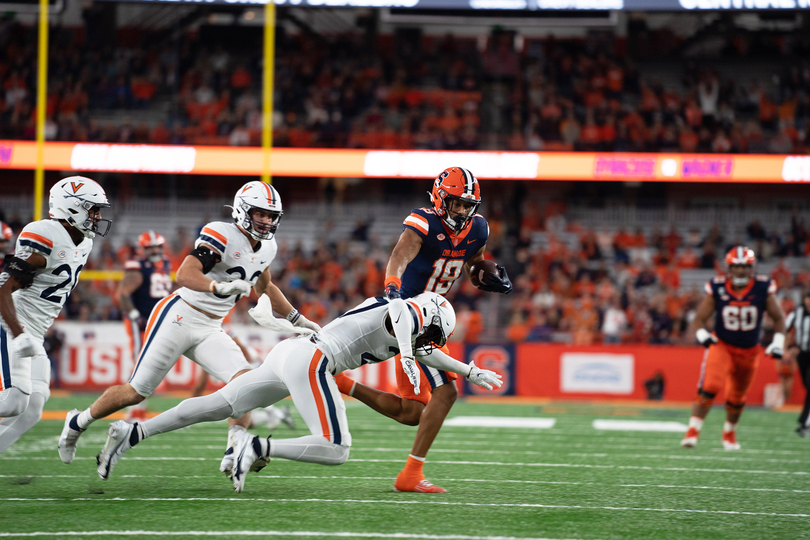Oronde Gadsden II’s 2nd breakout season keyed by patience, adjustments

“The cat’s out of the bag now. People are going to be looking for No. 19.” Oronde Gadsden’s emergence as Syracuse’s top receiver has followed years of waiting his turn in high school and college Emily Steinberger | Senior Staff Photographer
To support student journalism and the content you love, become a member of The Daily Orange today.
For years, Oronde Gadsden II has waited his turn. First in high school, when his team, littered with future Division I and NFL players, didn’t need him as a freshman or sophomore. Then in college, when his team, led by a generational running back, didn’t need wide receiver depth.
But Gadsden stayed patient. He worked on getting stronger and faster. He played special teams and changed his position. By his junior year of high school, he was a go-to target. Likewise during his sophomore year of college.
Entering the spring of his sophomore year of high school, Gadsden looked like a “totally different guy,” according to then-head coach Patrick Surtain Sr. That fall, Gadsden notched 21 receptions for 428 yards and six touchdowns. In a second-round playoff game against local power Miami Northwestern (Fla.) High School, Gadsden took a slant pass 60 yards, juking several players on the way.
Gadsden’s father, Oronde, who played in the NFL for seven years and won a Super Bowl, thought to himself, “maybe we got something here,” after that play.
The plan has always been for Gadsden to be better than his dad, Oronde said. But Gadsden played on American Heritage (Fla.) High School’s JV team as a freshman and appeared sparingly as a sophomore. He was frustrated going against future NFL defensive backs like Patrick Surtain II in practice. But he slowly developed into the team’s top receiver and a legitimate Power Five recruit.

Megan Thompson | Digital Design Director
Today, Gadsden is the best receiver on a nationally-ranked Syracuse team. He doesn’t consider himself a clear No. 1 target. But statistically, it’s not close. Gadsden has brought in 23 receptions (nine more than anyone else) for 366 yards (over 172 more than anyone else). He’s the only SU player with multiple touchdown catches, including his 25-yard game-winner against Purdue.
“I knew he had it in him,” Oronde said. “He just needed to get a shot. And that’s what he got. And he’s making the best of it.”
Gadsden had breakout years both in high school and at Syracuse. American Heritage has sent nine players to the NFL over recent years, including defensive backs Tyson Campbell (Jaguars) and Surtain II (Broncos). He learned “by fire” in practice, his dad said. Gadsden came home from practice upset about being unable to get off the line in scrimmages against Campbell and Surtain II, but his dad knew he wouldn’t have to go against that caliber in games.
Gadsden responded by improving his game. Once a “scrawny” kid, Gadsden developed into the 6-foot-5, 216-pound player he is now. He got his bench press up to 350 lbs, and finished fifth in the 300m hurdles state championship as a senior. Former American Heritage players in Division I or NFL programs came back over the summer to help Gadsden improve. He started jumping over defensive backs and snatching balls out of the air in practice.
“To see him out there and making plays on some of the best DBs in the country, we knew that he had a chance to be a Power Five guy,” Surtain said.
Last year, Gadsden played mostly on special teams and only garnered two receptions for 24 yards. The Orange finished last in the Atlantic Coast Conference in passing yards per game. Gadsden was frustrated, wanting to catch more passes and ease up Tucker’s load, Ordonde said.
Then Robert Anae entered as SU’s offensive coordinator. The offense became more pass-heavy, and Gadsden moved from outside receiver — where he’d always played — to a hybrid of slot receiver and tight end. He was asked to block more and make catches in the middle of the field.
So far, everything’s worked out. Syracuse is averaging nearly 100 more passing yards and two more touchdowns per game than last season. Gadsden’s been a go-to target in critical situations, like when the Orange needed a first down in the fourth quarter against Purdue, or later when they had to find the end zone to maintain a perfect record.

Emma Kelly | Design Editor
“He knows how to catch the ball. He knows how to run routes. He’s been there before,” head coach Dino Babers said. “What he does on the practice field, he does in the game.”
Moving inside also forced Gadsden to work on his blocking. In high school, Surtain preached that if receivers didn’t block, they wouldn’t get the ball. Gadsden “relished” getting the chance to block, frequently driving defensive backs into the ground, Surtain said.
When Syracuse lost one of its best run blockers, Chris Elmore, to a season-ending injury against Louisville, it turned to Gadsden, among others, to replicate the missing production. Gadsden learned more about who to block and where to place his hands and shoulders from Elmore. He said after the UConn game that it’s a 50-50 balance in practice between the time he spends run blocking and catching passes.
As he developed at American Heritage, Gadsden collected nearly 20 scholarship offers. But when the pandemic hit, he couldn’t visit any schools, and most places that offered him didn’t follow through — except for Syracuse, Surtain said. He had a difficult senior year, dealing with a COVID-19-laden season and an injury to his team’s starting quarterback, leading to almost 250 fewer receiving yards than the year before.
But Gadsden had already shown the Orange what he could do. His breakout season as a junior, brought about through his work in the weight room, on the track and against future pros in practice, precipitated everything he’s done this year.
“The cat’s out of the bag now,” Oronde said. “People are going to be looking for No. 19.”




